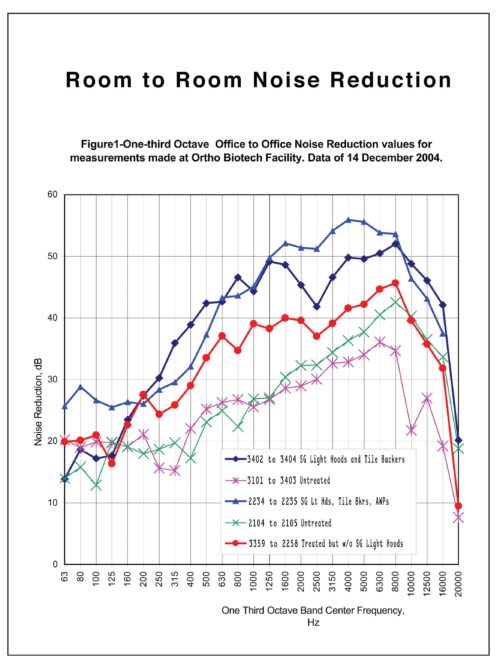SPIRIT ACOUSTICS PROJECT REPORT
Prepared For:
Mark Yanchuck, AlA
One Johnson & Johnson Plaza
New Brunswick, NJ
ORTHO BIOTECH
430 Route 22
Bridgewater, New Jersey
Speech Privacy Report
Office Isolation Measurements
Before and After
Products Installed
A – Fixture Acoustic Inhibited Transmission Hood
B – Flexible Acoustic Tile Enhancer
C – (Limited Areas) Acoustical Wall Treatment
Spirit Acoustics Inc.
2612 South Clinton Ave.
South Plainfield, NJ 07080
January 18, 2005
18 January 2005
Mr. Mark Yanchuk, Architect
One Johnson & Johnson Plaza
New Brunswick, NJ 08933
Re: Office Isolation Measurements at Ortho Biotech Route 22 Facility
Dear Mark:
This letter will summarize our findings regarding airborne sound isolation at the Ortho Biotech facility in Bridgewater, New Jersey.
Spirit Acoustics has been installing systems to improve the office-to-office isolation in the facility. The drop tile acoustical ceiling had been identified as the flanking path providing for poor speech isolation. Spirit Acoustics is installing a backing on the top of the ceiling tiles to provide increased transmission loss. In addition, acoustic fixture hoods are being installed above the light fixtures to reduce this flanking path. Finally, in some spaces wall treatment in the form of fabric covered glass fiberboard is being applied. Our measurements indicate that these various measures have provided a significant improvement in the isolation between spaces.
1. Background
Airborne sound describes sounds that travels from office to office in either direction and includes conversational speech and noise from equipment such as computers. The transmission path is not structure borne (vibration) although by necessity, part of the path is via the structure. Airborne Isolation is described in terms of the STC (Sound Transmission Class), or NIC (Noise Isolation Class). The measurement of these parameters is made by producing broadband noise in one room and measuring the one-third octave spectrum in the source and receiving rooms. The difference in the measured sound levels is then adjusted for the receiving room acoustical characteristics for STC measurements (unadjusted for NIC measurements) and curve fitted to provide a one number rating of isolation performance. The basic differences between the two measures is that the STC value is a rating of the demising structure performance (wall between offices), while the NIC value describes the obtained isolation in the specific installation. NIC is therefore the best metric to assess the speech isolation provided by the entire construction, walls, ceiling, interior materials, etc.
2. Data Acquisition and Results
We visited the facility on the evening of 14 December 2004 to carry out isolation measurements. The measurements were made using a Bruel & Kjaer Type 2250 Precision Sound Level Meter/Real Time Analyzer. A powered loudspeaker with signal from a pink noise generator was placed in one office, and the system was adjusted to provide a sound pressure level of 95 to 100 decibels. Measurements were made at eight locations in the office in which the loud speaker was placed (source room). The source was left running and the measurements were repeated in the receiving office at similar locations. Measurements of background noise in the receiving space were made with the sound source off to ensure that the receiving sound levels were the result of the sound source and not other unrelated noise sources. Measurements were made in a total of 5 office pairs described in Table 1.
3. Results
The measurement results are provided in Figure 1 and summarized in Table 1. The NIC values are calculated by curve fitting the third octave data to a standardized curve using an ASTM specified procedure. It is clear from the measurements that the treatment is effective in increasing the noise reduction (average sound pressure level in source room -average sound pressure level in receiving room) and therefore increasing privacy between the spaces. The NIC values for the treated rooms were 15 points higher than the untreated rooms. Further, the light hoods are an integral part of the system, with half the increase in noise reduction resulting from the addition of this component of the system. Where the fixture hoods were not yet installed (3359 and3358), the noise reduction was noticeably. lower than the fully treated rooms. The wall treatment also increases (mainly high frequency) noise reduction and provides some increase in performance.


